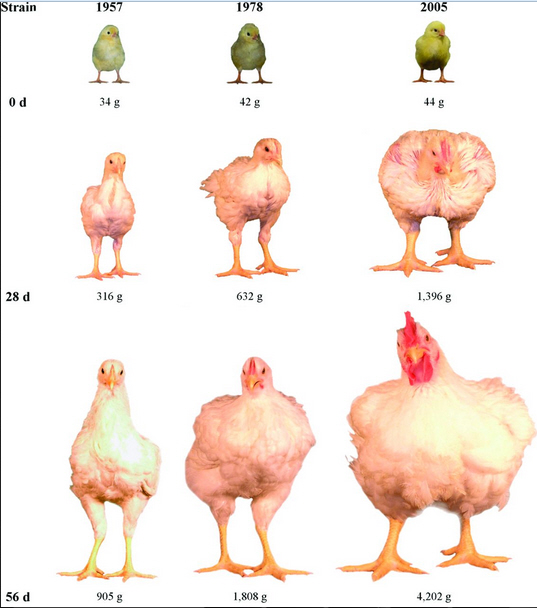



Growth, Efficiency and Yield of Commercial Broilers from 1957, 1978 and 2005
A study in Alberta, Canada, reveals that almost 50 years of commercial quantitative genetic selection pressure has achieved the intended beneficial changes in broiler performance. Some unintended consequences, however, represent challenges that may need to be addressed in future selection programmes.The effect of commercial selection on the growth, efficiency, and yield of broilers was studied using two University of Alberta Meat Control strains unselected since 1957 and 1978, and a commercial Ross 308 strain (2005) by Martin Zuidhof of the University and co-authors there and with Alberta Agriculture and Rural Development.
In their paper in Poultry Science, they explain that they placed mixed-sex chicks (n=180 per strain) into four replicate pens per strain, and reared them on a current nutritional programme to 56 days of age.
Weekly front and side profile photographs of eight birds per strain were collected. Growth rate, feed intake and measures of feed efficiency including feed conversion ratio, residual feed intake and residual maintenance energy requirements were characterised. A non-linear mixed Gompertz growth model was used to predict bodyweight and bodyweight variation, useful for subsequent stochastic growth simulation.
Dissections were conducted on eight birds per strain semiweekly from 21 to 56 days of age to characterise allometric growth of pectoralis muscles, leg meat, abdominal fat pad, liver, gut and heart. A novel non-linear analysis of covariance was used to test the hypothesis that allometric growth patterns have changed as a result of commercial selection pressure.
From 1957 to 2005, broiler growth increased by over 400 per cent, with a concurrent 50 per cent reduction in feed conversion ratio, corresponding to a compound annual rate of increase in 42 days live bodyweight of 3.30 per cent.

Within each strain, images are of the same bird at 0, 28 and 56 days of age.
Forty-two-day feed conversion ratio decreased by 2.55 per cent each year over the same 48-year period.
Pectoralis major growth potential increased, whereas abdominal fat decreased due to genetic selection pressure over the same time period. From 1957 to 2005, pectoralis minor yield at 42 days of age was 30 per cent higher in males and 37 per cent higher in females; pectoralis major yield increased by 79 per cent in males and 85 per cent in females.
To counter a surprisingly widespread popular misunderstanding of the underlying mechanisms behind rapid broiler growth, Zuidhof and co-authors say it is important to note the basis for this transformative change in productivity.
Modern chickens grow quickly because they have tremendous genetic potential to grow. Traditional selection methods – breeding efficient and robust birds with high growth rates – have been a particularly successful strategy in poultry because of high reproductive rates and short generation times.
There have been lessons along the way, the Alberta researchers continue. Unintended consequences to selection have proven challenging for the broiler industry, and will likely continue to emerge in spite of a high level of diligence manifested through comprehensive balanced selection programs.
Many unintended changes such as increasing sexual dimorphism are not likely to become problematic, according to Zuidhof and co-authors, but musculoskeletal biomechanics, changes in immune response and the implications of the huge growth potential on the welfare of breeding stock will undoubtedly challenge primary meat-type poultry breeders for the foreseeable future.
Reference
Zuidhof M.J., B.L. Schneider, V.L. Carney, D.R. Korver and F.E. Robinson. 2014. Growth, efficiency, and yield of commercial broilers from 1957, 1978 and 2005. Poultry Science. 93 (12):2970-2982. doi: 10.3382/ps.2014-04291
December 2014








